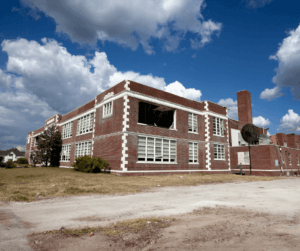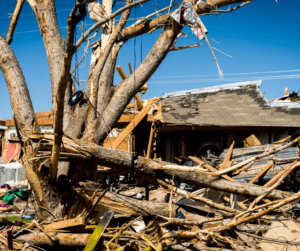A natural disaster can occur at a moment’s notice. Just one act of nature can cause a significant interruption to your business or even damage, destroy, or force you to close your doors. This is especially true in our part of the country where tornadoes are going to happen every year.
Unfortunately, companies that haven’t implemented a disaster recovery plan before the unthinkable happens are less likely to reopen their doors after a loss. We have a few tips for reopening your business after a natural disaster.
Tips for Reopening Your Business After a Natural Disaster
According to the Federal Emergency Management Agency (FEMA), up to 40 percent of businesses don’t reopen following a disaster, and another 25 percent close their doors within one year of a disaster.
To best position your business, you need a roadmap to get you through the disaster and recovery phases. Companies that have a detailed plan in place have a better chance of survival.
Create a Detailed Natural Disaster Plan
If your business is going to survive a natural disaster, you’ll need a detailed preparedness plan in place. One of the best tips for reopening your business after a natural disaster is to be prepared before one occurs.
An excellent disaster recovery plan should address all the issues your business may face and how you respond.
At a minimum, your plan should address the following areas:
- What disasters are likely to impact your business? What natural disasters are common in my area?
- What happens if a natural disaster occurs while employees are in the building? What are safe options for facility evacuation? Do you have a list of employees and building occupants?
- Who will be in charge during the disaster? How will responsibilities be delegated during this time?
- Do you have fully-stocked emergency kits? Do employees know where to find emergency equipment?
- How will you communicate with clients and customers during and after a disaster? What kind of messaging will you use to keep everyone in the loop about your business?
- Do you have emergency contact information for each employee? How will you communicate with employees?
- How will the business operate if the physical space is damaged? Is there an off-site location from which employees can work until doors reopen?
- How do you plan to protect and access vital business records and information if materials are destroyed, or you can’t access the space? What technology is needed to access information?
- Where is the contact information for the business’s insurance company, financial institutions, and a reputable disaster restoration company? What information will be critical to get our business back up and running?
When creating your plan, you should get feedback from your team members. Employees often will think of tips for reopening your business that you may not have considered.
Once you have developed a plan, be sure to review the plan with your employees. Make sure everyone feels comfortable with the procedures. If you need help creating your plan, print out FEMA’s business continuity and disaster preparedness plan, fill in your company’s information, and ensure critical employees know the details.

How to Prepare Before a Natural Disaster
Every business should conduct an annual risk assessment. That will help identify threats your business faces. You should outline financial and structural hazards a natural disaster could impose. Consider other businesses in your area or industry. They will provide a good source for tips for reopening your business.
Financial Considerations
The financial impact of a natural disaster can be massive for your business. Depending on the situation, you may have to close your facility for a period, replace inventory, or provide customer refunds.
You should understand how various disasters would impact your cash flow, sales, expenses, and debt. Experts recommend businesses keep a cash reserve equal to three to six months of expenses. That will help provide financial security while you get back up and running.
While developing your plan, note areas where you have concerns and work to improve weaknesses. Consider your monthly costs, including rent, mortgage, utilities, loans, payroll, and inventory. These considerations may help you cut expenses and try to save up in reserves. Building a cash reserve takes time, but making changes before a disaster can save your business down the road.
Physical Considerations
Have your building inspected for hazards and consider risk factors for disasters like hurricanes, floods, and tornados. The evaluation should include the building and equipment. Additionally, keep in mind technology and data that power outages may impact.
Check your business emergency equipment. This equipment includes backup generators, and electrical units regularly to ensure they are working correctly. If there are any problems, you should address them immediately. Regularly test systems, including fire detectors, extinguishers, sprinkler systems, exit lighting, and other safeguards. Some checks may be able to be done by staff, while others may require outside expertise.
Sign up for power outage alerts that may provide a little time to prepare the business and employees. Some power outages happen with little warning, so your plan should include identifying critical equipment that can run on the backup generator.
Getting your business back up will likely require access to data. You’ll want to have the ability to access insurance documents, payroll information, and tax forms. Consider other information that is critical to your recovery or business processes.
If you still have a lot of paperwork, you should ensure copies are stored at an off-site location. Electronic files should be backed up in a cloud-based storage system, as this will allow you to access the information quickly.
Understand Your Insurance Coverage
The worst time to find out something isn’t covered by your insurance policy is after the damage happens. Meet with your insurance agent and review your business coverage. Understand your policy limits and what is excluded from your insurance. You may want to consider additional coverage if you find large areas of exposure.
Develop a Communication Plan
An essential part of your plan will be keeping your customers and clients informed. Tips for reopening your business include details on messaging during and after the disaster. Consider all current ways you communicate with your customers and how you can effectively use those methods during a disaster. Consider ways to use social media posts, emails, text messages, or media alerts to provide important updates.
As soon as you can, keep your customers informed about what’s happening with your business. Provide an estimate of when you’ll be able to reopen for business. If multiple people are answering questions, be sure they are providing consistent information.

Train and Communicate with Your Employees
Employees will play a key role before, during, and after a disaster. Providing employee training can prevent unnecessary accidents, a quicker response time, and possibly minimize damage.
Employees should know building escape plans, disaster preparedness protocols, and any hazardous materials information. They should be familiar with the locations of fire extinguishers and first aid kits. In addition to first aid kits have items on hand such as hand sanitizer, gloves, masks, flashlights, batteries, and phone chargers. You may consider offering basic CPR and first aid training to your employees or having designated staff trained in these areas.
Remember that your ability to recover from a natural disaster might largely depend on how quickly your employees can return to work. Reach out to your team, and work with them to make scheduling changes if necessary so everyone can get back to normal as soon as possible.
Keeping your team updated after a disaster will be necessary. Employees will want to know the impact on their role during recovery and if they need to make any temporary changes.
Seek Outside Help
While FEMA provides financial assistance to businesses that are located in a federally declared disaster area, the process of receiving aid can take some time, especially when an astronomical number of claims are being filed. Have a backup plan in place to ensure you’re able to cover the costs of repairs in a punctual manner.
Consider purchasing a flood insurance plan that explicitly covers natural disasters. The Small Business Administration (SBA) may also be an excellent place to turn for help. Through the organization’s Office of Disaster Assistance, businesses in declared disaster areas can apply for low-interest, long-term loans to make repairs and replacements.
How ServiceMaster Restoration by RSI Can Help
If the unexpected does happen, remember that you’re not alone. At ServiceMaster Restoration by RSI, we understand how important it is for you to have your business restored as quickly and cost-effectively as possible. Our team of experts will guide you through the recovery process.
We also offer priority response agreements where your business can benefit from:
- Priority response
- 24/7/365 onsite within 2-4 hours as conditions allow
- Redundant solutions when a regional or CAT event occurs
- Pro-active response
- Pre-agreed pricing
- Dedicated account manager
Call ServiceMaster Restoration by RSI at OKC: (405) 251-7286 TULSA: (918) 492-8506 | ADA: (580) 795-3448 | SEMINOLE: (580) 795-3448 to learn how we help your business prepare and recover from a natural disaster.

